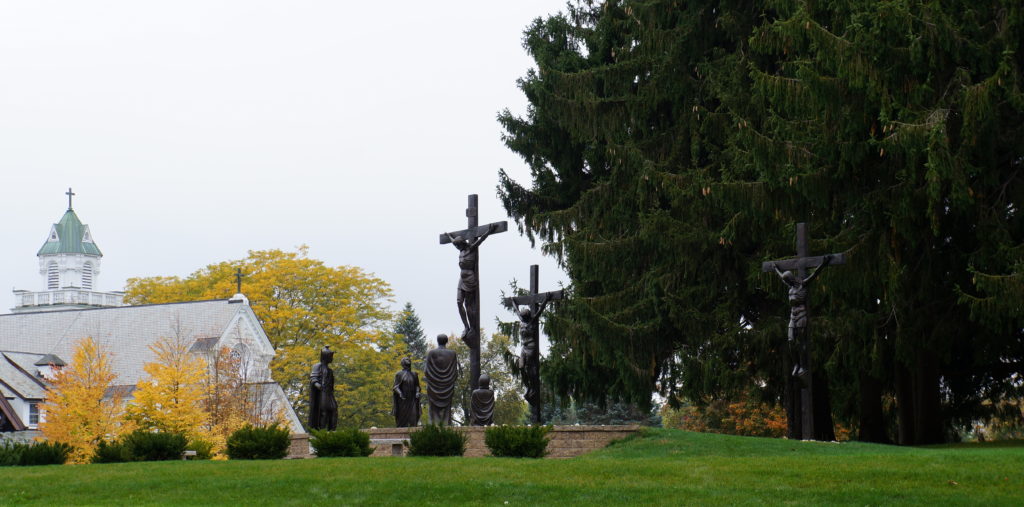In October of 2013, my husband and I were living north of Boston, and on a whim one Saturday morning we decided to drive with our four kids across the state of Massachusetts to Stockbridge to visit the National Shrine of Divine Mercy. It wasn’t entirely random; I’d been really wanting to go—St. Faustina was the first saint I loved and had taken as patroness at my baptism and confirmation (along with St. Thérèse of Lisieux). It was also the 75th anniversary of her death, so there would be an especially large gathering at the Shrine.
It was a beautiful drive, just as one would expect in New England in the fall; the trees that lined the turnpike were red and golden-hued, the air was crisp, the sky was clear. My heart was full as our little family prayed the chaplet on the lawn. As I looked around at all the people gathered there, humbled by the multiple priests hearing Confessions and the lines that trailed behind them, I was moved, but also amused by God’s leading in my life. I first encountered St. Faustina right at the dawn of my awakening to Catholicism, and she walked quietly alongside me up to my baptism a few years later. At that time, I had no idea of the impact the message of Divine Mercy had made on the world, only what an impact it had made on my own life.
I first heard of St. Faustina in the basement of my boyfriend’s house when I was around 16 years old. At the time I would often walk to his house after school. We’d do some homework, then “watch a movie” in his basement (code for “make-out”). On that particular day, his mom had borrowed a movie from their church library and was very excited about it. I don’t know why I was willing to watch this obviously religious video; maybe because I was trying to be nice, acquiescing to her earnest recommendation of this B-quality documentary. Or maybe she knew our code language (it wasn’t altogether clever). But I actually did watch this movie. It was about a simple, Polish nun named Sister Maria Faustina who had received a message from Our Lord, a message of mercy for the whole world at a time when the evils that preceded World War II had already been unleashed, unbeknownst to her. Normally a skeptic of anything Catholic, I was moved by her life, by her suffering and humility, by her solitude and contemplation, by how much Jesus clearly loved her. I wanted that. And that image of Jesus… He is touching his heart, from which two streams flow: one red, one white— blood and water— just as it was at the crucifixion when his side was pierced. Underneath this gentle and heroic Christ is written the words: Jesus, I trust in You.

I couldn’t stop thinking about the Divine Mercy. Like the image of the Sacred Heart, it had found a foothold in my entire being. I typed “Divine Mercy chaplet” into the search engine on our computer at home. It was an accessible prayer—an appeal to God’s mercy by the suffering of His son, for the salvation of the world. There was also something about the recalling of His “sorrowful Passion” and the meditation on His suffering that appealed to me. I prayed the chaplet in secret every so often, and increasingly more as I grew closer to Our Lord and the Church.
At the time, I really needed not just the message of Divine Mercy, but the image too. Home life had become increasingly stressful as addiction reared its ugly head and demanded the full attention of us all. I needed to see that look of tenderness from Our Lord, and to remember that He poured Himself out for love of me. I needed to call out for mercy as an intercession for my family, but also for myself in the midst of what seemed hopeless; I needed that mantra of Jesus, I trust in You, when there was no clear path forward.
The Divine Mercy message, chaplet, image, and the holy example of St. Faustina herself would become a staple in my spiritual life: in my struggles with anxiety and scrupulosity, in prayer for loved ones struggling with addiction and other over-powering difficulties, and in just remembering Christ’s mercy for me in my own continual struggle with sin. God knows I wasn’t looking for it, and certainly not where I encountered it, but how sorely I needed it.

To learn more about St. Faustina and the Divine Mercy message, visit here. For more information about the National Shrine, visit here.
